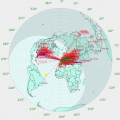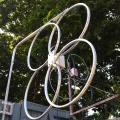The KiwiSDR 2 online store is open for orders! Please visit kiwisdr.nz
Please visit kiwisdr.com (documentation) and kiwisdr.nz (online store)
G8JNJ
About
- Username
- G8JNJ
- Joined
- Visits
- 3,720
- Last Active
- Roles
- Member
- Points
- 16
Reactions
-
Need to attenuate LW 252 Khz
>
> found that the notch was 34 dB deep, which was more than necessary. I 'softened' it to 20 dB with a series 2.2 ohm resistor.
>
Hi Richard,
That's good, you must have found an inductor with a good value of Q.
I've only ever been able to achieve a maximum of about 20dB using surface mount or small molded axial types.
You can widen or narrow the notch bandwidth by choosing different L/C ratios. The values I used were designed to provide some attenuation over the whole of the LW BC band, with a deep notch at the band center and minimal effect outside of the band (148-284KHz @ -3dB).
You can decrease the depth of the notch by adding low value series resistors as Richard suggests. When using surface mount inductors, I typically add 6.8 Ohms to this circuit to obtain a notch depth of 10dB, with 0 Ohms I can get about 17 to 20dB.
Here's a plot showing the measured performance of my BC band filters.
Regards,
Martin - G8JNJ -
Need to attenuate LW 252 Khz
Hi Mark,
Here's a simple notch that should do the trick and give you a 20dB deep notch on 252KHz.
It's just a series tuned circuit wired across the antenna feed into the KiWi.
You may need to fine tune either the inductor or capacitor value to get it spot on frequency, but these values should get you close.
If you buy a standard value pre-wound inductor, just play with parallel combinations of capcacitors to get near the correct value by watching the KiWi S-meter when tuned to 252KHz.
Regards,
Martin - G8JNJ -
Channel Button
Hi Stu,
This is an interesting idea, but it looks a bit cumbersome (if I understand what you are proposing correctly).
I wonder if another method would be to allow users to navigate by 'stepping' through the displayed DX tags.
If you then used the @ menu to filter the tags by name, it would allow you to select say just tags with 'CB' and then you could simply step up and down the tagged channels, perhaps perhaps using something like the left and right had arrows to select 'next' and 'previous' as would be the case using a Windows word search in a document.
This would also be useful feature for marine & aero channels among others, assuming they were tagged correctly.
Regards,
Martin - G8JNJ -
W/F and SND Bad Params
-
Seeed Metal case and GPIO connector
Hi Glen,
I think for me the main issue is that the interconnecting cables are not all bonded to the case at the point of entry with low impedance connections.
So RF currents will flow via separate routes across the PCB's and find various ways of interacting with the circuit components as a result.
By bonding at the point of entry, you preserve the screen around the whole assembly and don't provide an opportunity for differentials to be setup between cables.
Most of the cables connected to the KiWi are relatively straightforward and can easily be filtered and screened. However the Ethernet port is an exception, as this has its own filter network and balancing transformers contained within the actual PCB mounted Ethernet socket. The main issue with this, as far as I can tell, is that the components have been chosen to help comply with worldwide EMC regulations, most of which only apply above 30MHz. So their performance below this frequency, where we are mainly interested, can be somewhat hit and miss. If we can do away with the wired Ethernet connection, by using a USB WiFi dongle, then a lot of these problems simply disappear.
Here are some notes I copied from Keith Amstrong's very comprehensive notes on EMC compliance. They are free but you need to register your email address to be able to read them. They cover just about every aspect of EMC design, and you would have to complete a degree level training course, costing several thousands of pounds (or dollars) to have access to similar information.
The 'Past Articles' section is probably the quickest read, but it's worth taking a good look around if you have the time.
http://compliance-club.com/keitharmstrong.aspx
2.6.2 How shielded interconnections work
When a shield interacts with an EM-field, currents flow in the shield. Skin Effect makes RF currents travel on the surface of a shield, with current density diminishing with depth into the shields metal by 36% for every skin depth. The higher the frequency, or the more conductive the metal of the shield, the smaller is the skin depth. For good shielding effectiveness the shield should have many skin depths of thickness at the lowest frequency to be shielded. Skin effect is not described further here, but a useful reference is [8]. Figure 2P shows that providing we achieve our 360o shield coverage and 360o electrical bonding at shield joints, and have enough thickness in our shields metal given the frequency, the skin effect tends to force the external surface currents to flow on the outside of the shield, and the internal surface currents on the inside.
4.3.9 Near-field leakages through apertures
So far we have assumed that the source was so far away that its EM radiation was plane waves, i.e. the shield was in the far-field of the radiating source - the usual situation when trying to protect electronics from external RF sources (to improve immunity).
But when using shielding to reduce emissions from a product, the shield is usually in the near-field of the source - and the SE from plane wave assumptions can be very wrong indeed, especially at lower frequencies. The closer the RF source is to the apertures, the worse the SE. Very significant amounts of leakage can occur, especially at low frequencies, even through arrays of very small apertures that have very low SE for plane (far-field) waves, see [17] for more detail.
Figure 4R sketches the E and H fields around an aperture, indicating that they are associated with regions of reduced SE, where it would be inadvisable to locate noisy or sensitive components or conductors.
This is how to make 'sniffer' probes that you can use with your KiWi to track down interference sources.
1.1 Close-field probes
Close-field (also called 'near-field') magnetic and electric field probes are low-cost to buy and very quick and easy to make. They are commonly used in development, diagnostic and QA work. There are many articles and papers describing how to make various versions of such probes, and most EMC test equipment manufacturers also sell their own versions of them. Figure 1 shows the three main constructions for magnetic field probes.
Near-field probes should always use 50R cables, and the input impedance of the RF measuring instrument they are connected to should also be 50R. Where the test instrument does not have a 50R input option, use its high-impedance input but fit a 50R BNC terminator at the instrument end of the probe's cable, for example using a BNC 'Tee' piece or through-line terminator. The 50R termination helps stop resonances in the probe cable which would otherwise occur when its length exceeds one-tenth of the wavelength of the highest frequency of interest (e.g. 50R termination is necessary for cables longer than 300mm for a highest frequency of only 50MHz - remembering that the wavelength for a signal in a cable is roughly half that of an electromagnetic wave in free space).
Figure 2 shows a standard electric field probe design, and also a 'pin probe'. The pin probe is a voltage probe which makes contact to the circuit or metalwork of interest via a 10pF capacitor, and it picks up the common-mode (CM) voltage as well as the signal voltage. CM voltage is a big contributor to radiated emissions. Magnetic field probes are shielded so that they don't pick up electric fields, which can sometimes leave them 'blind' to an important source of emissions. Usually, for small products, it is the CM currents leaking out via cables that cause most of the radiated emissions, but sometimes it is the electric field caused by the CM voltage on the body of the EUT itself, so electric field or pin probes have an important part to play.

Regards,
Martin - G8JNJ -
W/F and SND Bad Params
-
Seeed Metal case and GPIO connector
Hi All,
I've had some issues with radiated noise from a KiWi that I installed on a shared site. The main issues were that it was interfering with of VHF satellite reception and degrading the GPS performance of another system in the same room.
The KiWi was installed in the Seeed metal case, and I had fitted ferrites to the cables.
As I'm currently building up a KiWi for installation at another site, I thought that it would be a good idea to see if I could further reduce the level of emissions from a KiWi fitted in the Seeed case.
In order to do this I used an EMC H-Probe consisting of a 1"diameter screened loop connected to a spectrum analyser, in order to see what the level of emissions looked like and where they were escaping from the case.
The majority of the noise was leaking out through the holes in the ends of the case and also via the additional interconnecting cables I had fitted to bring out the GPIO ports for antenna switching.
This shows the general level of radiation from a KiWi without a case, with the Seeed metal case and with the Seeed case and additional modifications. Note that the measurements were made without the external GPIO cable connected.
The next shot shows the difference between the Seeed metal case and with the Seeed case and additional modifications in more detail.
As you can see the biggest difference is achieved by fitting the metal case, and I would definitely recommend doing this if you are still using the plastic frame supplied with the KiWi.
However there is still a fairly significant amount of radiated noise throughout the whole spectrum, especially in the VHF / UHF / Microwave range, and the only way to cure this is to close up the holes in the box.
As I didn't want to restrict airflow and ventilation I used some very fine woven brass mesh that I previously bought for antenna construction.
I added a section of mesh at each end of the box and sandwiched it between the end plates and the box sides, having first cutout suitable holes for the connectors I still wished to use.
Note that I had to solder short brass sheet straps between the Ethernet port metal socket surround and the mesh and also the -ve of the DC input connector where it enters the board (prior to the common mode choke on the board) in order to reduce the level of radiated noise from the external screened CAT5 Ethernet cable and DC power cable. There already was physical / electrical contact between the mesh and Ethernet connector, but I noticed that the screening effectiveness varied as I flexed the cable, and I didn't want to risk problems on-site at a later date if the mesh tarnished or developed an oxide layer.

Here are a couple of external views, showing the wire mesh with the case closed.

Once I had done this work I still had some noise from the GPIO port, so I added some 0.1uF decoupling capacitors and some 1/8th watt 1K Ohm resistors in series with the wires from the KiWI GPIO pins (not the 0v ground return) and the decoupled pins of the output connector. This also provided some short circuit protection, as previously suggested as best practice earlier in this thread.

After doing all of this work, the level of emissions are now minimal, and the ambient level of noise in my workshop is higher than the majority of noise produced by the KiWi, even though the close field probe is right next to the case. There is still a bit of radiation along the seams between the top and bottom case halves, but this is very low level, and if necessary can be further reduced by running self adhesive aluminium (ducting) tape over the seams.
One other interesting observation is that before fitting the mesh and additional earth bonding strap, I didn't find that using screened Ethernet cable made much difference to the level of noise radiated around 20MHz. However after performing the modification it's really noticeable that using screened cable makes a big difference.
Overall I think the additional mods are worth doing, especially if you are bringing the GPIO pins out of the box. But if you are already housing your KiWi in a diecast box with suitable cable bonding, then you are probably already experiencing most of the benefits I have observed.
Regards,
Martin - G8JNJ -
Seeed Metal case and GPIO connector
Hi All,
I've had some issues with radiated noise from a KiWi that I installed on a shared site. The main issues were that it was interfering with of VHF satellite reception and degrading the GPS performance of another system in the same room.
The KiWi was installed in the Seeed metal case, and I had fitted ferrites to the cables.
As I'm currently building up a KiWi for installation at another site, I thought that it would be a good idea to see if I could further reduce the level of emissions from a KiWi fitted in the Seeed case.
In order to do this I used an EMC H-Probe consisting of a 1"diameter screened loop connected to a spectrum analyser, in order to see what the level of emissions looked like and where they were escaping from the case.
The majority of the noise was leaking out through the holes in the ends of the case and also via the additional interconnecting cables I had fitted to bring out the GPIO ports for antenna switching.
This shows the general level of radiation from a KiWi without a case, with the Seeed metal case and with the Seeed case and additional modifications. Note that the measurements were made without the external GPIO cable connected.
The next shot shows the difference between the Seeed metal case and with the Seeed case and additional modifications in more detail.
As you can see the biggest difference is achieved by fitting the metal case, and I would definitely recommend doing this if you are still using the plastic frame supplied with the KiWi.
However there is still a fairly significant amount of radiated noise throughout the whole spectrum, especially in the VHF / UHF / Microwave range, and the only way to cure this is to close up the holes in the box.
As I didn't want to restrict airflow and ventilation I used some very fine woven brass mesh that I previously bought for antenna construction.
I added a section of mesh at each end of the box and sandwiched it between the end plates and the box sides, having first cutout suitable holes for the connectors I still wished to use.
Note that I had to solder short brass sheet straps between the Ethernet port metal socket surround and the mesh and also the -ve of the DC input connector where it enters the board (prior to the common mode choke on the board) in order to reduce the level of radiated noise from the external screened CAT5 Ethernet cable and DC power cable. There already was physical / electrical contact between the mesh and Ethernet connector, but I noticed that the screening effectiveness varied as I flexed the cable, and I didn't want to risk problems on-site at a later date if the mesh tarnished or developed an oxide layer.

Here are a couple of external views, showing the wire mesh with the case closed.

Once I had done this work I still had some noise from the GPIO port, so I added some 0.1uF decoupling capacitors and some 1/8th watt 1K Ohm resistors in series with the wires from the KiWI GPIO pins (not the 0v ground return) and the decoupled pins of the output connector. This also provided some short circuit protection, as previously suggested as best practice earlier in this thread.

After doing all of this work, the level of emissions are now minimal, and the ambient level of noise in my workshop is higher than the majority of noise produced by the KiWi, even though the close field probe is right next to the case. There is still a bit of radiation along the seams between the top and bottom case halves, but this is very low level, and if necessary can be further reduced by running self adhesive aluminium (ducting) tape over the seams.
One other interesting observation is that before fitting the mesh and additional earth bonding strap, I didn't find that using screened Ethernet cable made much difference to the level of noise radiated around 20MHz. However after performing the modification it's really noticeable that using screened cable makes a big difference.
Overall I think the additional mods are worth doing, especially if you are bringing the GPIO pins out of the box. But if you are already housing your KiWi in a diecast box with suitable cable bonding, then you are probably already experiencing most of the benefits I have observed.
Regards,
Martin - G8JNJ -
Seeed Metal case and GPIO connector
Hi All,
Just some brief notes regarding the installation of a 15 way D connector on the Seeed metal case in order to bring out the GPIO port for use with an antenna switch.
The ventilation slot cuts out very easily and only required a small amount of filing in order to make the connector shell fit.
First the pinout I used
End view of case
Top view of connector
Wiring to GPIO ports
Side view
Hope this is of some use to others.
Regards,
Martin - G8JNJ -
Seeed Metal case and GPIO connector
Hi All,
I've had some issues with radiated noise from a KiWi that I installed on a shared site. The main issues were that it was interfering with of VHF satellite reception and degrading the GPS performance of another system in the same room.
The KiWi was installed in the Seeed metal case, and I had fitted ferrites to the cables.
As I'm currently building up a KiWi for installation at another site, I thought that it would be a good idea to see if I could further reduce the level of emissions from a KiWi fitted in the Seeed case.
In order to do this I used an EMC H-Probe consisting of a 1"diameter screened loop connected to a spectrum analyser, in order to see what the level of emissions looked like and where they were escaping from the case.
The majority of the noise was leaking out through the holes in the ends of the case and also via the additional interconnecting cables I had fitted to bring out the GPIO ports for antenna switching.
This shows the general level of radiation from a KiWi without a case, with the Seeed metal case and with the Seeed case and additional modifications. Note that the measurements were made without the external GPIO cable connected.
The next shot shows the difference between the Seeed metal case and with the Seeed case and additional modifications in more detail.
As you can see the biggest difference is achieved by fitting the metal case, and I would definitely recommend doing this if you are still using the plastic frame supplied with the KiWi.
However there is still a fairly significant amount of radiated noise throughout the whole spectrum, especially in the VHF / UHF / Microwave range, and the only way to cure this is to close up the holes in the box.
As I didn't want to restrict airflow and ventilation I used some very fine woven brass mesh that I previously bought for antenna construction.
I added a section of mesh at each end of the box and sandwiched it between the end plates and the box sides, having first cutout suitable holes for the connectors I still wished to use.
Note that I had to solder short brass sheet straps between the Ethernet port metal socket surround and the mesh and also the -ve of the DC input connector where it enters the board (prior to the common mode choke on the board) in order to reduce the level of radiated noise from the external screened CAT5 Ethernet cable and DC power cable. There already was physical / electrical contact between the mesh and Ethernet connector, but I noticed that the screening effectiveness varied as I flexed the cable, and I didn't want to risk problems on-site at a later date if the mesh tarnished or developed an oxide layer.

Here are a couple of external views, showing the wire mesh with the case closed.

Once I had done this work I still had some noise from the GPIO port, so I added some 0.1uF decoupling capacitors and some 1/8th watt 1K Ohm resistors in series with the wires from the KiWI GPIO pins (not the 0v ground return) and the decoupled pins of the output connector. This also provided some short circuit protection, as previously suggested as best practice earlier in this thread.

After doing all of this work, the level of emissions are now minimal, and the ambient level of noise in my workshop is higher than the majority of noise produced by the KiWi, even though the close field probe is right next to the case. There is still a bit of radiation along the seams between the top and bottom case halves, but this is very low level, and if necessary can be further reduced by running self adhesive aluminium (ducting) tape over the seams.
One other interesting observation is that before fitting the mesh and additional earth bonding strap, I didn't find that using screened Ethernet cable made much difference to the level of noise radiated around 20MHz. However after performing the modification it's really noticeable that using screened cable makes a big difference.
Overall I think the additional mods are worth doing, especially if you are bringing the GPIO pins out of the box. But if you are already housing your KiWi in a diecast box with suitable cable bonding, then you are probably already experiencing most of the benefits I have observed.
Regards,
Martin - G8JNJ







